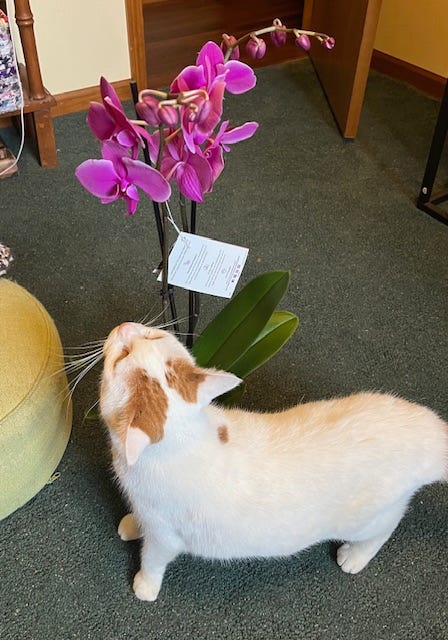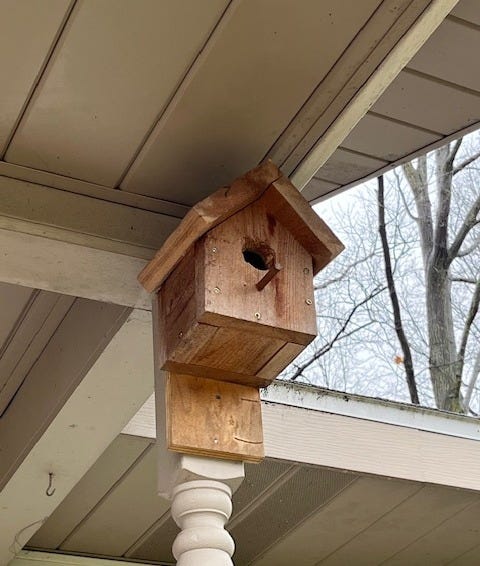The wrens left.
They came, they hatched, they flew the coop.
To be more accurate, they left the wooden birdhouse that had been their home for several weeks last summer. We’d listened to their song and watched the results of their nest-building efforts - first, the male built the platform with twigs so long they stuck several inches out of the birdhouse; then the female finished the cup part of the nest. A day or two later she laid eggs, and for a couple of weeks the only visible activity was the occasional foray in search of food.
Then -
The Hatching and Departure
We heard cheeps that sounded more like screams: FEED US! The only bird sightings occurred when one of the adult would approach with a juicy, sometimes squirming, morsel.
This went on until a Saturday just over two weeks after the hatching. What a gift that I just happened to be looking out the window the minute three small, dark fledglings emerged from the nest and flew into a nearby tree!
I was watching a small farewell.
That was the last we saw of the Wren Family. They were noisy and a little sloppy as houseguests go, but we missed them.
Another Departure
Last week after a couple of months of her gradually worsening cough, I took Phoebe, our 14-year-old cat, to the vet. She showed no signs of pain and was eating well, but one night as she was coughing while sitting on my lap, I knew it was time to get her examined. (Pet owners, have you experienced this with your pets? This sudden certainty that action is needed now? It doesn’t feel like an emergency, just a knowing: it’s time to take action. Do Not Delay.) I had delayed the visit not through lack of concern, but in knowledge of Phoebe’s absolute terror at riding in the car and being handled by strangers in a building that carries the scent of thousands of other cats.
I booked an appointment for Friday. Following an unremarkable exam, the vet took an x-ray - just in case, he said. Afterwards he returned to the exam room, visibly shocked by what he had seen: a tumor was occupying the bottom third of Phoebe’s right lung. He started to discuss options before I told him what would happen next. This was not, after all, my first rodeo.
In the three days that followed, Phoebe stopped eating - a validation of my earlier feeling that we needed to take action. She passed peacefully in my arms at home on Monday, under the auspices of an in-home euthanasia provider. I couldn’t control her illness, but I could give her an early exit.

I had known this was coming at some level - let’s be honest; all pet owners know what the end game will be, even as they assume the role of pet guardian. I spent a lot of time appreciating her company and quirkiness with this heightened knowledge in the weeks that preceded her death.
A New Guest
Back to last summer. Shortly after the wrens literally flew the coop, I was sitting in the love seat from which I could see both their birdhouse and the Japanese maple in front of our porch. A glint caught my eye, and I saw that a small-ish, nondescript brown spider was spinning her web, walking delicately, slowly, in concentric circles as she spun out the silvery thread that, reflected in the morning sun, had caught my eye.
I watched the circle dance for a moment before trying to film the web construction with my phone. When I looked at the video though, all I saw was a brown spider walking in slow, apparently aimless circles waving two of its legs. The web was invisible in the video, and the spider looked confused - literally “going in circles.”
Focus on Purpose
What an obvious life lesson. It’s almost embarrassing to say it out loud. What we see depends on our lens - our perspective, our focus. A shift in focus, a better camera, or no camera at all, would allow me to see the purpose in this spider’s movements; yet anyone watching my video would wonder what the big deal was. A spider is walking in circles. Because of the limitations of video, they would not see the most important part of the action - the web. With no understanding of purpose the actions make no sense. (Timing was in her favor, by the way; if she’d shown up a few weeks earlier her purpose might have been to serve as food for a hungry fledgling wren.)
The wrens did what they were supposed to do; Their purpose was to procreate, and they were successful. They won’t be the last birds in that house.
Pets bless our lives for a finite time, but the love they give us is infinite. I’m grateful for Phoebe’s thirteen years with us, but I’m also grateful that I recognized time was short. What was the purpose in her life with us? I imagine that will play out further with time and perspective, but for the last year or so I’ve believed that her purpose was to recognize when I needed comfort. Once I recognized this, I was no longer irritated when she tried to sit on my lap when I was angry or sad. And my ultimate purpose was fulfilled with that final action.
In general, children grow up and move on; the process is painful but they are hopefully building a life and community that will sustain them when we are gone. This is my enduring hope, and it sustains me in the face of the countless small goodbyes that occur with my son as he puts down new, hopefully strong, roots in California, which he now calls home. (This seems like a non sequitur, right? I know - I haven’t mentioned this in the article. I’ve talked about it in so many other posts that I just didn’t want to rehash his departure, but the experience is relevant.)
This line of thought naturally led me to wonder what my purpose in life is. I suppose it’s important to define an overreaching Purpose, whether we call that a values statement or a bucket list of sorts, but we also have an opportunity to recognize and honor smaller purposes as they arise. (Looking back at our lives, we might be able to identify times when we missed the opportunity to fulfill one of those purposes, but it can be hard to do this without guilt or angst - if you are me.)
Although I think of writing as my big, mountain-top Purpose - and there’s a lot to unpack there - in reality, needlework has served as the most important and consistent vehicle for the smaller (by which I mean more easily achieved and less time-consuming) purposes, which have almost always involved supporting others. I’ve written other posts about this in my knitting newsletter so I won’t reiterate them here but will include links below. I honor those small purposes whenever they present themselves, and this knowledge keeps me from being self-critical regarding my lack of progress on writing. After all, when we’re writing we’re not knitting (or crocheting or painting or embroidering etc.), and when we’re knitting we’re not writing. Both activities are means of manifesting, and both are acceptable, along with myriad other ways of creating.
Catching those opportunities to fulfill a purpose requires preparation (maybe having a stock of finished knitted items, to present one when the need appears) and focus.
We can focus on purpose, and we can focus - on purpose.
I think I’ll end here, because that sentence blew my mind. Below are the previously mentioned posts from this publication and my Lake Effect newsletter that discuss needlework as a vehicle for connection.






Not sure why I am just finding this, but I too had wrens last year and I think they have returned. At least I saw them for a day or two. I also have a friend who just lost her beloved pet. So this is a synchronicity. I love the idea of small moments of purpose. Although I see a large purpose for my life, I only accomplish it in small bites week after week so for me, the macro and the micro are one in the same. Thanks for letting me think about that.
Love that last line, too - much food for thought